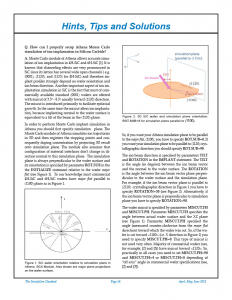Hints, Tips and Solutions
Q. How can I properly setup Athena Monte Carlo simulation of ion implantation in Silicon Carbide?
A. Monte Carlo module of Athena allows accurate simulation of ion implantation in 4H-SiC and 6H-SiC [1]. It is known that channeling effects are very pronounced in SiC since its lattice has several wide open channels ( e.g. 〈0001〉, 〈1120〉, and 〈1123〉 for 4H-SiC) and therefore implant profiles strongly depend on wafer orientation and ion beam direction. Another important aspect of ion implantation simulation in SiC is the fact that most of commercially available standard 〈0001〉 wafers are offered with miscut of 3.5° – 8.5° usually toward 〈1120〉 direction. The miscut is introduced primarily to facilitate epitaxial growth. In the same time the miscut alters ion implantation, because implanting normal to the wafer surface is equivalent to a tilt of the beam in the (1120) plane.
In order to perform Monte Carlo implant simulation in Athena you should first specify simulation plane. The Monte Carlo module of Athena simulates ion trajectories in 3D and then registers the stopping points and consequently doping concentration by projecting 3D result onto simulation plane. The module also assumes that configuration of material interfaces don’t change in direction normal to this simulation plane. The simulation plane is always perpendicular to the wafer surface and its orientation is specified by parameter ROT.SUB in the the INITIALIZE statement relative to the wafer major flat (see Figure 1). To our knowledge most commercial 4H-SiC and 6H-SiC wafers have major flat parallel to (1100) plane as in Figure 1.



